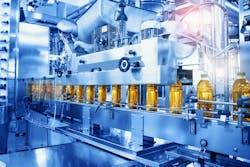Trade shows such as Pack Expo are all about bright lights, soft carpets and amazing products and services. This year’s Pack Expo show in Chicago seemed to be brighter than normal, and it took me just a little bit of time to realize that the light was coming from the machines themselves. This is a trend that has been coming on for a while, but it has been embraced by the machine builders.
Traditional machinery will come with a light stack to provide information to the operator and others on the line as to the status of the machine. Typically, this might involve a red/yellow/green stack, similar to a stop light, indicating stopped, manual and automatic function.
Get your subscription to Control Design’s daily newsletter.
Combinations of flashing and solid illumination can provide further information like faults, moving in manual or downstream not ready. Adding a blue light might signal a material shortage. Strategic placement of these signal lights helps to reduce downtime but alerts others to pending or current issues with a piece of machinery.
Depending on the size of the equipment, it is often hard for an operator or maintenance tech to see what is going on down in the bowels of the equipment. The addition of work lights at specific areas in the machine can help greatly with this need. However, hardware vendors have leveraged the placement of these lights within the machine envelope to provide signal, in addition to functional lighting to the machine.
Light-emitting diode (LED) clusters and full-on light bars now have multi-color functionality. A nice bright white light might be used to illuminate an area when a door is open and someone is in there doing work.
Once the doors are closed and you are ready to return to operation, the light bar takes on the same functions as the light stack in a traditional system. It can flash red to show a fault or blue to indicate that a magazine or glue system is low. It can flash green if the machine is running but something downstream isn’t ready to receive.
Read more of Rick's reporting from Pack Expo: Robots and augmented reality continue to evolve
Depending on the size of the operation, light bars can be located on different stations of the machine to put the same functionality of the lights in a more specific region of focus. Better yet with this technology, network connectivity means that these devices can be quickly deployed and used in a control design. There are versions available for most network protocols, including IO-Link.
Reviewing the as-always compressed trip through the various floors of the show, one further thing came to light. Gazing over these modern marvels, the part that was missing was the junction boxes. Over the years, the base machine of a builder tends to stay the same. Some of these were born in the 1970s and 1980s. There is a robust base frame and way of making a machine that could be used by an observer to identify the brand of machine or the lineage in the situation where new vendors have splintered off of other vendors through the years.
These tubular frame constructions were specifically designed to provide an internal pathway through the machine for wires and hoses to protect them from the outside world as much as possible. While this is still the same, the method by which the signals get from the field back to the control panels has changed.
Watch interviews from Pack Expo: R.A Jones Celestion MTX machine includes overhead plug-and-play cabinets
Gone are the days where a bundle of wires originates at the control panel, passes through a flexible conduit to the machine frame and then back out a flexible conduit to the field device. Most packaging machines employ a field-mounted I/O block with home run cables for just power and network connections. The savings for the equipment vendor is huge, and there is value added. That the field-mounted block, in most cases, can be configured to have both inputs and outputs in the same block.
As the wiring systems have gotten easier, it becomes an easier decision for the control designer to include more sensors in their designs, and this promotes a tighter control system because the machine function can be based on actual position of devices rather than an assumed position with some fluff time to make sure it arrives.
It's good to get out and smell the roses once in a while. Trade shows are a great way to do this, both for machine builders and end users. It is human nature to find a groove and stay in it, but the real progress happens when we have room to innovate and expose ourselves to inspiration.
About the Author
Rick Rice
Contributing Editor
Rick Rice is a controls engineer at Trew Automation, a material handling manufacturer based in West Chester, Ohio. With over 38 years’ experience in the field of automation, Rice has designed and programmed everything from automotive assembly, robots, palletizing and depalletizing equipment, conveyors and forming machines for the plastics industry but most of his career has focused on OEM in the packaging machinery industry with a focus on R&D for custom applications.

Leaders relevant to this article:

